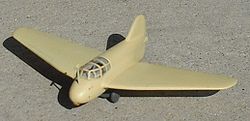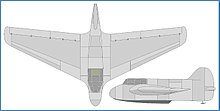DFS 194
| DFS 194 | |
|---|---|
 Model of the DFS 194 |
|
| Type: | Test aircraft |
| Design country: | |
| Manufacturer: | |
| First flight: |
Summer 1941 (with drive) |
| Number of pieces: |
1 |
The DFS 194 was a test aircraft of the German Research Institute for Glider Flight (DFS).
development
The first draft shown in Alexander Lippisch's book “A triangle flies” shows a single-engine, tailless fighter with a pusher propeller and downward-hanging wing tips like the direct predecessors DFS 39 and DFS 40 .
The aircraft was built after Hellmuth Walter had completed the Walter drive named after him and thus a powerful rocket engine was available for a high-speed test aircraft. A tailless aircraft was particularly suitable for installing a rocket engine. The development of the airframe was entrusted to Alexander Lippisch, whose aircraft “ Ente ” had already carried out the successful rocket flight in 1928 and which was considered to be the leading capacity for tailless aircraft designs.
In contrast to the basic design, the angled wing tips were dispensed with, as they could possibly tend to flutter in high-speed flight. Instead, the fuselage was designed with a vertical tail. In January 1939, Lippisch and a dozen of his employees moved from DFS to Messerschmitt AG because the project could not be continued in the civilian research institute of DFS. This marked the beginning of the military development of the project into a research vehicle for high-speed fighter aircraft with rocket propulsion.
In order not to complicate matters unnecessarily, it was decided to do without a landing gear and let the machine land on a skid. The take-off took place - as was common in gliding at the time - on a drop-off single-axle trolley.
Flight tests with rocket engines began in the summer of 1941. A Walter R 1-203 rocket engine with 300 kp (2.9 kN) thrust was used, with which the aircraft reached 550 km / h. The DFS 194 was one of the direct predecessors of the Messerschmitt Me 163 and was already very similar to its first prototype, the Me 163A V4.
Technical specifications
| Parameter | Data |
|---|---|
| crew | 1 |
| length | 7.20 m |
| span | 9.30 m |
| height | |
| Wing area | 17.52 m² |
| Empty mass | |
| Takeoff mass | 2100 kg |
| Top speed | 550 km / h |
| Engines | a Walter R 1-203 ; 2.9 kN thrust |
literature
- Heinz J. Nowarra : The German Air Armament 1933-1945. Bernard & Graefe, Koblenz 1993, ISBN 3-7637-5464-4 .
Web links
Individual evidence
- ↑ Hans-Peter Diedrich: The German rocket planes until 1945. Aviatic, Oberhaching 2001, ISBN 3-925505-61-X , p. 147

